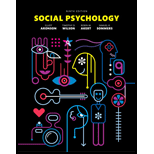
Introduction
The propinquity effect is simply the positive relationship between proximity and attraction. In short, the more often you see someone the more likely you are to be attracted to them. This attraction can be romantic or sexual, but it need not be. It can easily take the form of friendships and trust among neighbors. Functional distance also plays an important role. People who are brought together by geographical or architectural circumstances also feel this closeness, even though they may not live or work in close proximity to one another.
Explanation of Solution
Correct answer and explanation
In this case, the correct answer is option (B). Marge works near the elevator and the kitchen. This likely brings her into contact with a large number of her co-workers every day. The propinquity effect tells us that this would likely make her very popular. Her colleagues see her often, which leads to a feeling of attraction and emotional closeness.
Explanations for incorrect options
Option (A) refers to Bart, who doesn't like his neighbor. The late-night music and Bart's difficulty with sleeping would lead to animosity, which would create a NEGATIVE relationship between the proximity and attraction of the two neighbors. As the propinquity effect refers to a positive relationship, this cannot be the correct choice.
Option (C) refers to Homer, who prefers to avoid running into people he may not want to interact with. This avoidance of interaction does not allow the propinquity effect to take place.
Option (D) refers to Lisa, who didn't make as many friends in her freshman year as she did her sophomore year. Although the architectural circumstances (for instance, where her room was located) may have had some effect on this, we simply do not have enough information to attribute this to functional distance. There are any number of factors which may have played a part in this.
Want to see more full solutions like this?
Chapter 10 Solutions
Social Psychology (9th Edition)
 Social Psychology (10th Edition)SociologyISBN:9780134641287Author:Elliot Aronson, Timothy D. Wilson, Robin M. Akert, Samuel R. SommersPublisher:Pearson College Div
Social Psychology (10th Edition)SociologyISBN:9780134641287Author:Elliot Aronson, Timothy D. Wilson, Robin M. Akert, Samuel R. SommersPublisher:Pearson College Div Introduction to Sociology (Eleventh Edition)SociologyISBN:9780393639407Author:Deborah Carr, Anthony Giddens, Mitchell Duneier, Richard P. AppelbaumPublisher:W. W. Norton & Company
Introduction to Sociology (Eleventh Edition)SociologyISBN:9780393639407Author:Deborah Carr, Anthony Giddens, Mitchell Duneier, Richard P. AppelbaumPublisher:W. W. Norton & Company The Basics of Social Research (MindTap Course Lis...SociologyISBN:9781305503076Author:Earl R. BabbiePublisher:Cengage Learning
The Basics of Social Research (MindTap Course Lis...SociologyISBN:9781305503076Author:Earl R. BabbiePublisher:Cengage Learning Criminalistics: An Introduction to Forensic Scien...SociologyISBN:9780134477596Author:Saferstein, RichardPublisher:PEARSON
Criminalistics: An Introduction to Forensic Scien...SociologyISBN:9780134477596Author:Saferstein, RichardPublisher:PEARSON Sociology: A Down-to-Earth Approach (13th Edition)SociologyISBN:9780134205571Author:James M. HenslinPublisher:PEARSON
Sociology: A Down-to-Earth Approach (13th Edition)SociologyISBN:9780134205571Author:James M. HenslinPublisher:PEARSON Society: The Basics (14th Edition)SociologyISBN:9780134206325Author:John J. MacionisPublisher:PEARSON
Society: The Basics (14th Edition)SociologyISBN:9780134206325Author:John J. MacionisPublisher:PEARSON





